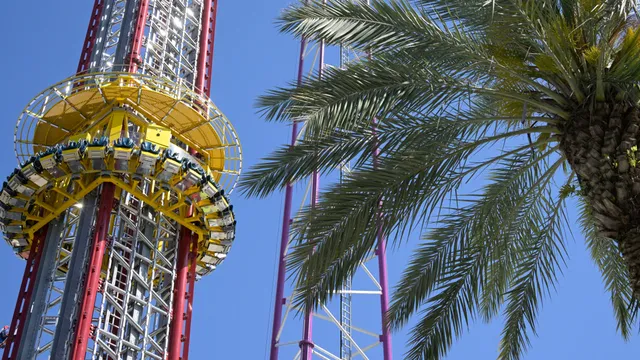
Maintenance tech exposes ignored safety issues before Orlando teen's tragic fall
2025-03-20 19:28- A former technician reported that safety issues with the FreeFall ride were ignored prior to the death of Tyre Sampson.
- Campbell-Alexander stated he observed life-threatening safety management failures, including manually bypassed safety sensors.
- The lawsuits and investigations surrounding these safety breaches highlight the need for stricter enforcement of safety protocols.
Express your sentiment!
Insights
In Orlando, Florida, a tragic incident occurred on March 24, 2022, when a 14-year-old boy named Tyre Sampson fell to his death from the FreeFall drop tower at ICON Park. The boy, who was 6-foot-5 and weighed approximately 360 pounds, was over the ride's height and weight limits, which may have contributed to the incident. A former maintenance technician, Austin Campbell-Alexander, has filed a lawsuit alleging that safety concerns were disregarded in the weeks leading up to the accident. He claimed to have noticed issues with seat safety and ride integrity since January 2022, and reported that seats were manually bypassed to accommodate larger patrons. This override was done by an operations manager, which Campbell-Alexander stated was knowingly dangerous. Despite reporting these concerns to his supervisor, the practices continued, with no proper training or follow-up on safety protocols provided to employees. In the days leading up to the tragedy, Campbell-Alexander and another technician observed additional safety failures, including a hot locking mechanism that could prevent seat security and cracks in structural joints of the ride's gondolas. After the incident, Campbell-Alexander stated he was pressured to falsify maintenance logs during the investigation, which he refused, leading to his suspension and eventual termination a year later. This raises serious questions about safety management and regulatory compliance in amusement parks. Legal actions stemming from this accident emphasize the potential negligence on the part of the ride operators and the corporate environment surrounding the decision-making processes related to ride safety. In Maryland, the National Transportation Safety Board (NTSB) reported that the Maryland Transportation Authority (MDTA) failed to conduct crucial vulnerability assessments before the collapse of the Key Bridge. Their investigation concluded that if such assessments had been completed based on recent vessel traffic, the MDTA could have identified risks associated with a possible collapse due to vessel collisions. The NTSB's findings indicate that since structural assessments were not conducted, there was no proactive strategy to mitigate the risks that ultimately led to the bridge's failure. During this assessment, it was noted that specific power failures on the Dali vessel ahead of the incident also contributed to the overall safety concerns. As investigations continue, the MDTA has initiated pre-construction activities to rebuild the Key Bridge, with plans to enhance structural resilience and safety protocols in future operations. These incidents collectively underscore critical issues surrounding safety oversight in public infrastructure and amusement facilities, highlighting the responsibility to ensure safety protocols are effectively implemented to prevent tragedies. The legal and investigative outcomes from these cases may lead to reforms aimed at enhancing safety standards in such recreational and transportation infrastructure.
Contexts
The ICON Park FreeFall ride, which has garnered considerable attention due to its design and height, necessitates a thorough examination of its safety regulations. Given its status as one of the tallest free-standing drop towers, the ride poses unique operational and safety challenges. Safety regulations are crucial in ensuring the well-being of all riders, particularly for thrill rides that attract a vast array of patrons, including families and young adults. The ride’s mechanical systems, including the restraint mechanisms, braking systems, and the entire operational framework, must be regularly inspected and maintained to comply with safety standards set forth by relevant authorities in amusement park operations. To ensure rider safety, the park implements stringent age, height, and weight restrictions, which are critical for determining the suitability of an individual to participate in the ride. These parameters are established based on biomechanical research and testing that considers the structural integrity of the ride and the forces experienced by riders during operation. Additionally, staff training is imperative; all personnel interacting with guests must be knowledgeable about safety protocols, emergency procedures, and the operation of the ride to ensure a safe experience. Regular drills and training sessions can assist employees in proficiently managing emergency situations. Inspection schedules are an integral part of ride safety regulations. Thorough pre-opening inspections, as well as routine checks during operating hours, ensure all components of the FreeFall ride are functioning correctly. This continuous monitoring contributes to the identification and rectification of any potential safety hazards, thereby reducing the likelihood of incidents. The regulatory framework often mandates these inspections be conducted by certified engineers and safety professionals who have expertise in amusement ride operations and safety standards. In conclusion, the ICON Park FreeFall ride epitomizes the thrill associated with modern amusement park attractions while also highlighting the paramount importance of rigorous safety regulations. Through diligent adherence to safety measures, proactive maintenance, and thorough employee training, the ICON Park aims to deliver an exhilarating yet secure experience for its guests. Continuous evaluation and the adoption of best practices in safety regulations remain essential in maintaining not only the integrity of the ride but also the trust and satisfaction of its patrons.